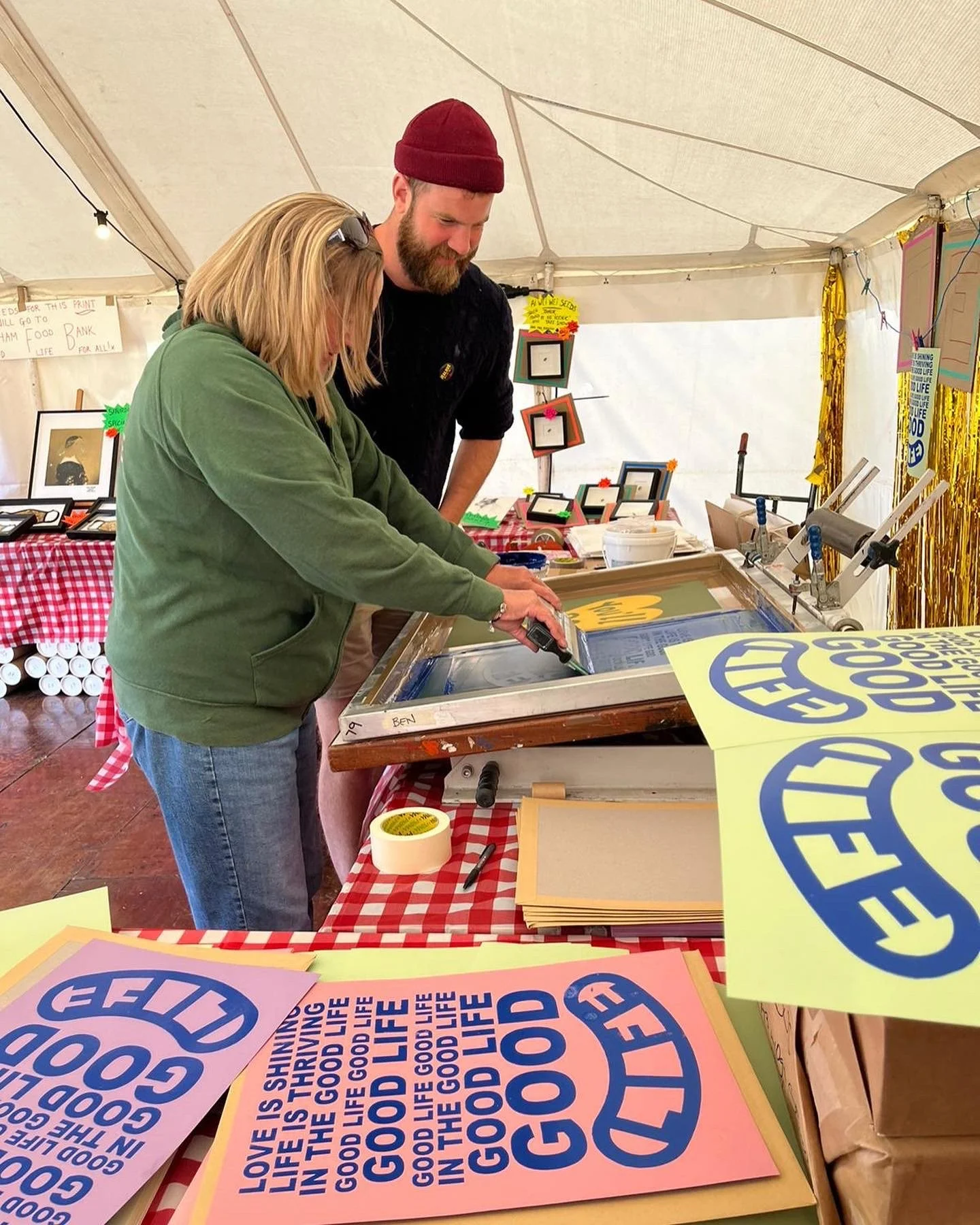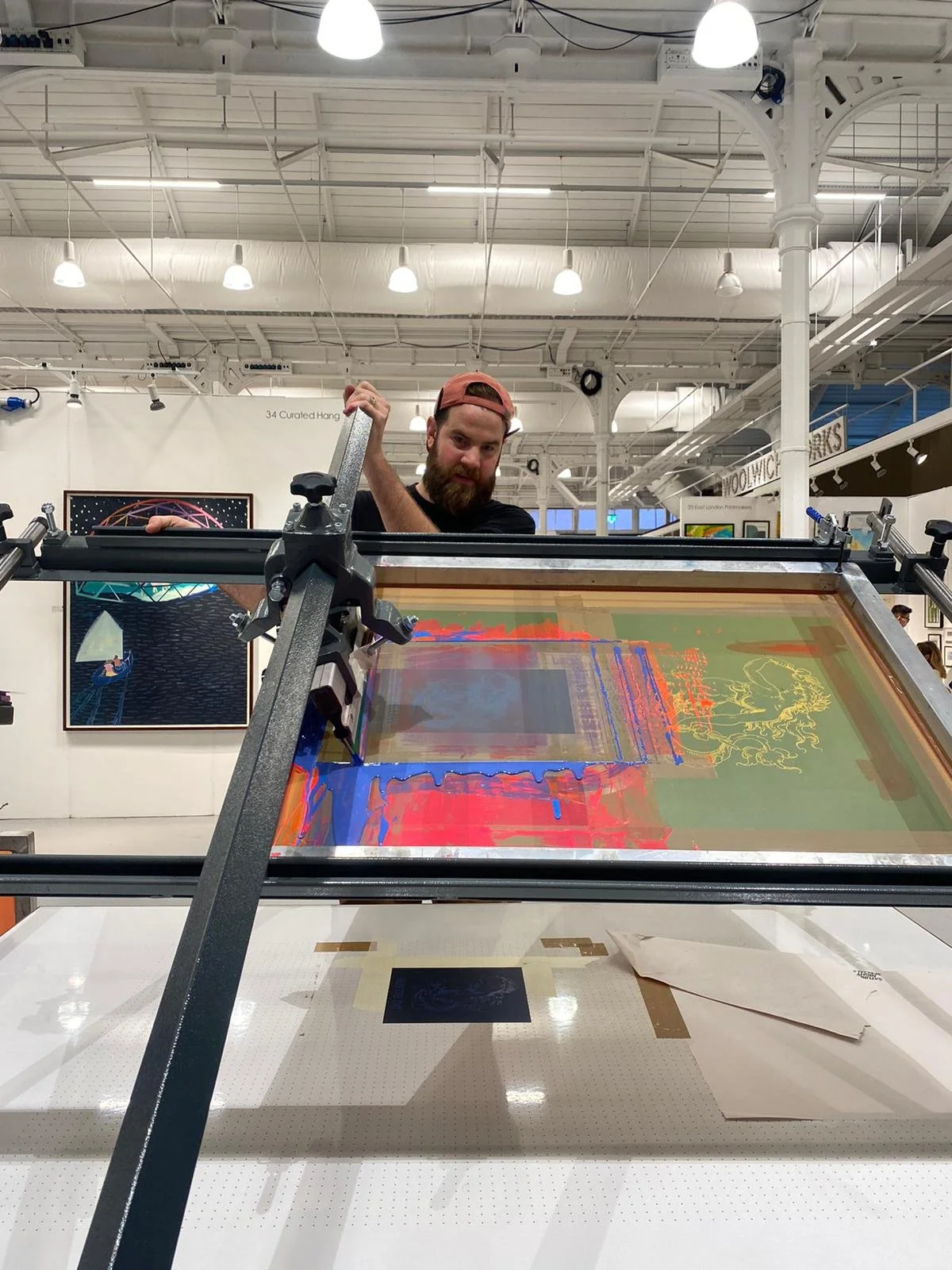From Plympton to Print Legend: In Conversation with Ben Challen or Bench Allen…
From the skies of Plympton to the vibrant print studios of London, Ben Challen’s journey as a printmaker is a story of curiosity, creativity, and a deep-rooted love for the natural world. In this exclusive conversation ahead of Print in Action 2025, ‘Bench’ reflects on his artistic path — from studying Illustration and Print in Plymouth to becoming a lead screenprinter at the renowned Jealous Print Studio. He shares how his environment shapes his work, why printmaking remains a joyful and essential craft in a digital age, and what visitors can expect from his energetic demonstrations at this year’s festival. As he puts it, “If one person does a workshop with me or sees my work and gets into printmaking themselves, then I’m blooming happy.”
This is a story of passion, persistence — and the unmistakable spirit of disco.
Can you describe your artistic journey and how you became involved in printmaking?
So, I studied Illustration and Print at Plymouth College of Art, moved to London not knowing what I’d like to do with my life, but my aim was to go into book making or screenprinting. I saw a job as a print technician but didn’t have any experience in commercial printing, so applied for a few internships. The first one was at Jealous Print Studio, loved it and then very quickly into the internship I was offered a part time job, which turned into a full-time job, which turned into my life – living and breathing screenprinting. Now here I am.
What themes or subjects do you find yourself repeatedly exploring in your work?
I guess I’ve always described my work as wordless narrative inspired by the nature, which includes raising awareness and love for our world, through this my work has become more political than expected, culminating a few years ago in works like my ‘I want to be inside EU’ print, which ended up getting more attention than I’d expected, but allowed me to gain a larger audience. I love to think that my work always has some depth to it, documenting the amazing world we live in.
How does your environment influence your creative process and the imagery in your prints?
Well, a perfect example of how my environment has completely influenced me and my work, is my Avian Collection body of work. When I lived in Plymouth, more specifically Plympton, it felt like I was surrounded by birds all the time – Wood Pigeons, Gulls, Buzzards, Pheasants and everything in between. Once I moved to London though the skies were ruled by a bigger creature, the metal beasts of the sky, aeroplanes! From a distance though, with their trail of chem, they can be just as amazing and bring the same hope and joy as seeing great migrations or murmuration, I guess in a way it’s the great migration of humans.
Are there particular artists or movements that have significantly influenced your style?
In terms of screenprinters artists like Robert Rauschenberg, Eduardo Paolozzi, Patrick Caulfield, and obviously it’s hard not to say the Pop Art and Art Nouveau movements. Though I also find a lot of inspiration in film and cartoons, and of course illustration.
How do you balance experimentation with traditional printmaking techniques in your practice?
Fortunately for me I’m able to experiment whilst making other artist’s work at Jealous and get to talk through ideas with a massive selection of different printmaking minds.
Printmaking Techniques & Process
Which printmaking techniques do you primarily work with, and what draws you to them?
It’s always been about screenprinting for me. The very fact it’s such a versatile medium – you’re about to achieve a range of textures, you can be super graphic, or hand drawn or both within the same layer. If it can pass through the mesh, you’re able to print with it in some fashion. That’s the same for the substrates you can print on – paper, t-shirts, wood, brick, leather, glass, someone’s body – it’s all possible. The wild amount of colours is breathtaking and just so much fun. I think screenprinting will always be the technique that will never stop giving.
Can you walk us through your typical process from concept to finished print?
Usually start with an illustration or photograph or both. I will then draw up an idea of how I want the image to be, sometimes hand drawn or digitally or a collage of both. At this point I’ll usually decide the dimensions, loose colours etc. There might be a bit of back and forth at this point – there’ll be quite a bit of editing and indecisiveness on my part. Once I’m happy I’ll make all the separations – which is splitting the image into layers, adding a ‘trap’ (where two layers slightly overlap so you don’t have any gaps when printed) then print my acetates, make and expose my screens (making sure I know the type of screen I’d like for the colour I’m printing). I then mix my colours, which is always a highlight of the process, get the paper/substrate I’d like to print on prepped, and then print away. As it’s my work I like to experiment as I’m editioning, so that might mean getting a few more sheets of paper than the edition size so that if I’m not happy I’ll still have enough prints to make the edition size I’d like (obviously I can always make the edition a wee bit smaller than intended). Once the print is done and all the layers are dry I might make small edits, hand finish papers, cut or tear the paper down, finally sign, sealed, delivered.
What challenges have you encountered in your printmaking journey, and how have you overcome them?
Screenprinting on walls and windows will always be challenging as you’re printing with the screen vertical and printing on surfaces that can very uneven, porous or completely impermeable. The way I’ve been able to do these projects for example is set up jigs that can support the sign as I’m printing or, as some people may have seen on Instagram, I’ve created a makeshift way of printing windows, but it’s always worked.
Are there any new techniques or materials you're currently exploring?
Mixing hand painted backgrounds with screenprint over the top. You’re able to get lots of interesting textures and relief to the work
Involvement with Print in Action
What motivated you to participate in the Print in Action festival?
In my home town, celebrating what I love – it’s a win win situation. Going back to the very place where the source of all my inspiration comes from, where sea meets moor meets forest meets me.
Can you share what attendees can expect from your demonstrations and drop-in sessions?
A colourful exploration into what Plymouth means to them, through printmaking and the spirit of disco. They should also stick around on the Saturday session as I’ll be doing a talk straight after.
How do you see events like Print in Action contributing to the printmaking community?
It’s opening more people up to the joys of print and how accessible it can be. I believe that print has always been made by the people for the people, not for the rich elite with loads of money to spend on artworks worth crazy amount. Though in this digital age, it’s too easy to push a button and everything is made for you, especially now with AI, so I believe that we still need to keep with the handmade print processes and the best way to do this, and teach others, is for them to come try it themselves.
What are you most looking forward to during the festival?
I love being surrounded by the print community, as sometimes it feels like a niche little family, but once you see everyone together you realise it’s a big family of some of the nicest people you could ever meet. It’s always interesting to see and hear about what everyone’s been working on and learning new ways of doing a piece of work in print techniques you aren’t used to working in.
How do you prepare for engaging with the public during live demonstrations?
Like any project I’m working on, it’s about working out what could go wrong and preparing as much as I can. Though it’s also excepting that beautiful ‘mistakes’ might happen and rolling with it. I love making prints and seeing how people who are new to it come about making their print, quite a lot of the time they come up with things I’d never thought off.
Personal Reflections & Advice
What has been the most rewarding moment in your artistic career so far?
Recently having my work feature in an RSPCA advert was definitely a massive highlight of my artistic career – especially as they asked me.
How do you stay inspired and motivated in your practice?
I love what I do, after over a decade of doing it my mind now sees things in layers. I think like everything in life, you have to just set yourself tasks and goals, make up interesting bodies of work and keep on making.
What advice would you give to emerging artists interested in printmaking?
Be patient, trust the process and keep it simple to begin with – you don’t need to the best or the most complex straight away. It’s about building yourself and the work up, the best printmakers I know get maximum effect with minimum layers.
How do you envision the future of printmaking in the digital age?
Like I said before, there’s no replacement for something made by human hand plus, again, mistakes make a screen print what they are – the way layers and colours interact. The patience of waiting for an ink to dry, when you make a perfect screen, when you know you’ve made two layers line up the exact way you want them to or they don’t line up anything like you imagined them to but it works even better. You will never have that sort of fun in the digital world!
What legacy do you hope to leave through your art and community involvement?
If one person does a workshop with me or seeing my work and gets into printmaking themselves, then I’m blooming happy.
To see more of my work and what we’re working on at Jealous Print studio:
Website:
Instagram:
@benchallen
@jealous_london




